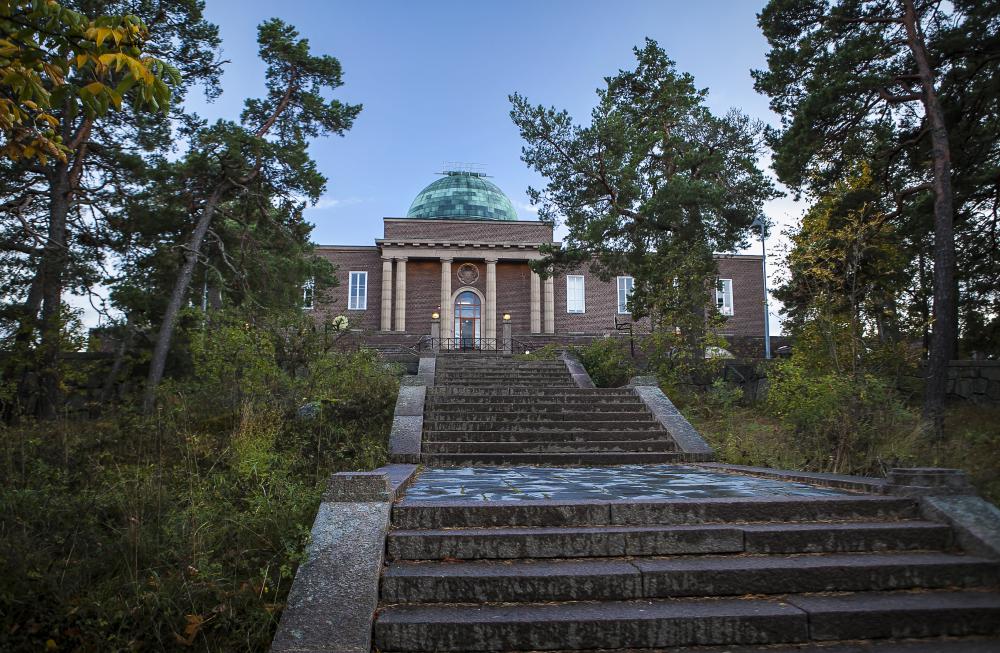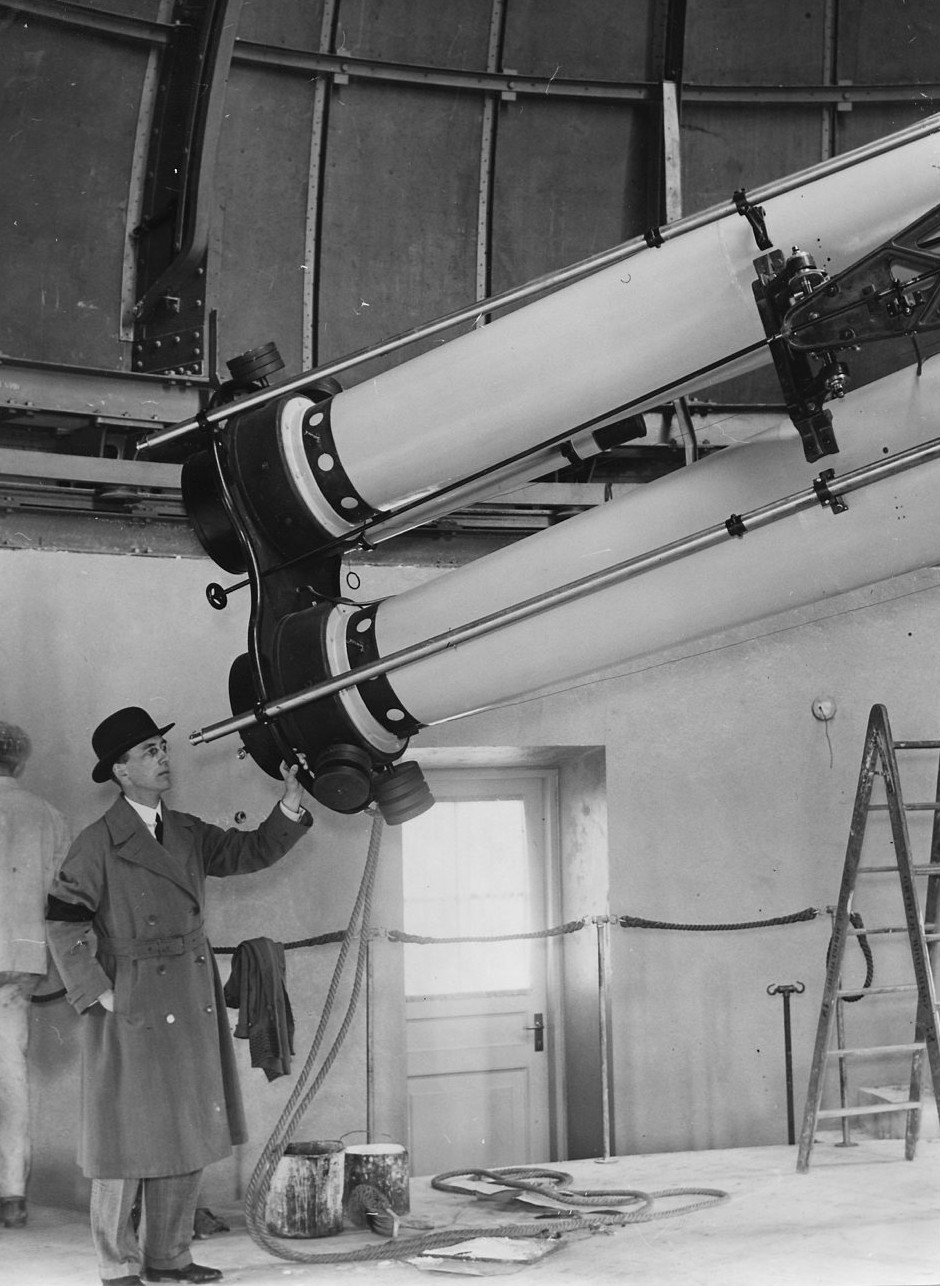
Category of Astronomical Heritage: tangible immovable
Saltsjöbaden Observatory, Södermanland, Sweden

Description
Location
Latitude 59.271819 N, longitude 18.304063 E. Elevation ??? m above mean sea level.
IAU observatory code
052
Description of (scientific/cultural/natural) heritage

Fig. 1a. Saltsjöbaden Observatory (1931), (CC3, Irina Jonsson)

Fig. 1b. Saltsjöbaden Observatory, architect Axel Anderberg (1931), (CC3, Holger Ellgaard)
In 1931 the new Stockholm Observatory in Saltsjöbaden,
south of Stockholm, Nacka municipality, was inaugurated. The architect was Axel Anderberg (1860--1937).
The main building was put on an elevation with surrounding smaller buildings for different instruments as well as a work-shop and living quarters for the staff. The observatory was donated by Knut and Alice Wallenberg Foundation. It was in astronomical use until 2001.
The observatory began to be built at the end of the 1920s when the light conditions at Stockholm’s old observatory had made scientific observations difficult.
In 1926, the astronomer Nils Nordenmark gave a lecture in which he called on the Royal Swedish Academy of Sciences and the city to do something about the observatory’s outdated and deficient equipment. This lecture inspired bank director Knut Wallenberg to take care of the observatory’s survival, and on his advice, in 1927, the Academy of Sciences appointed a committee to plan a new observatory facility. The location was chosen southeast of Stockholm for two reasons: first, the south is the most important latitude for astronomical observations and they wanted to avoid the light from the city; secondly, the cloudiness along the sea band decreases, which is why they headed out towards the archipelago, to the east. Karlsbaderberget in Saltsjöbaden was judged to be the most favorable place.

Fig. 2a. Saltsjöbaden Observatory (1931), (CC3, Holger Ellgaard)

Fig. 2b. Dome of Saltsjöbaden Observatory (1931), (CC3, Holger Ellgaard)

Fig. 3a. Saltsjöbaden Observatory (1931), (CC3, Holger Ellgaard)

Fig. 3b. Dome of Saltsjöbaden Observatory (1931), (CC3, Holger Ellgaard)
The Academy of Sciences received grants from the city and from the Knut and Alice Wallenberg Foundation, on the condition that the new observatory would continue to be called Stockholm’s observatory, and the building was started in 1929. The architect was Axel Anderberg (1860--1937), who designed the buildings in a heavy brick architecture. He was also the architect behind the Academy of Sciences’ building, the Swedish Museum of Natural History and the Stockholm Opera. The facility initially consisted of eight buildings and five observation domes.

Fig. 4. Bertil Lindblad (1895--1965), director of Stockholm and Saltsjöbaden Observatory 1927 to 1965 (credit: ESO)
Professor Bertil Lindblad (1895--1965), director of Stockholm Observatory 1927 to 1965, president of the International Astronomical Union (1948/52), had planned the observatory’s relocation. The new observatory was inaugurated on June 5, 1931 with King Gustaf V as the main guest. Bertil Lindblad was at this time of the opening of the Saltsjöbaden’s observatory 1931 the Academy of Sciences’ astronomer and was given the main scientific responsibility. Under his leadership, a number of new instruments were purchased: a double refractor, a mirror telescope and an astrograph, including instrument domes. Lindblad later became head of Stockholm’s new observatory.
The large number of optical telescopes collected here makes Saltsjöbaden’s observatory unique in the Nordic countries. The Schmidt telescope from 1963 has a 1-m-mirror, but is no longer used. The 40-inch-reflecting telescope is manufactured by Grubb & Parson in England, and was installed in the eastern 12-m-dome in 1931. In the main building there is a double refractor, a 50cm and 60cm lens telescope, Grubb & Parsons of Newcastle, also installed in 1931. Both of these telescopes are functional today. The work and instrumentation of Saltsjöbaden’s observatory was especially specialised for astrophysics -- no classical positional astronomy. Bertil Lindblad was interested in the properties of stars which would elucidate the structure of the Milky Way, and the rotation of the stellar system.
History

Fig. 5a. 40-inch-Reflecting telescope (102cm), Grubb & Parsons of Newcastle upon Tyne, UK (1931), (Creative Commons)

Fig. 5b. 24/20-inch-Double refractor, 50cm and 60cm, Grubb & Parsons of Newcastle upon Tyne, UK (1931), (Creative Commons)

Fig. 5c. 1-m-Schmidt telescope (1963), (CC3, Holger Ellgaard)
Instruments
- 1-m-Schmidt telescope (1963) -- no longer used.
- Astrograph, Carl Zeiss of Jena
- 40-inch-Reflecting telescope (102cm), Grubb & Parsons of Newcastle upon Tyne, UK (1931), installed in a separate building in the eastern 12-m-dome
- 24/20-inch-Double refractor, 50cm and 60cm, Grubb & Parsons of Newcastle upon Tyne, UK (1931),
installed on top of the main building in a dome of eleven meter diameter. - Radio telescope (now removed)
State of preservation

Fig. 5. Saltsjöbaden Observatory (1931), (CC3, Holger Ellgaard)
The observatory was declared a state building monument in 1993, and the same year the Swedish Property Agency took over the administration from the National Board of Construction.
Threats or potential threats
no threats
Present use
The observatory is now home to the Knowledge School’s Natural Science Center (KNC) for Development. In addition, Kunskapsskolan Saltsjöbaden is there, which has been rebuilt in the area to suit school activities. Since 1964, the astronomy association Stockholm Amateur Astronomical Club and its successor Stockholm Amateur Astronomers (STAR) have been located in two of the side domes. In 2002--2007, it was mainly only STAR, Ericsson’s Astronomy Association and Saltsjöbaden’s Samskola that were located at Saltsjöbaden’s Observatory.
Thus Saltsjöbaden Observatory is used as a private school and the telescopes are maintained by amateurs.
Astronomical relevance today

Fig. 6. AlbaNova 1-m-Reflecting telescope (2007), (photo: Magnus Naeslund, Stockholm University)
From 1931 to 2001, the Stockholm Observatory was located in the Saltsjöbaden Observatory, but the research institute was transferred from the Academy to Stockholm University in 1973 and is since 2001 moved in the AlbaNova University Centre, north of Roslagstull, consisting of a new astronomy, physics and biotechnology center.
In 2007, a modern 1-m-Reflecting telescope was installed in AlbaNova.
References
Bibliography (books and published articles)
no information available
Links to external sites
- Stockholm Observatory -- Saltsjöbaden
- Stockholm Observatory -- Saltsjöbaden, Sweden
- About the department / History -- Stockholm Observatory -- Saltsjöbaden
- Saltsjöbaden Observatory, Stockholm, Sweden (Atlas Obscura)
- Lars Karlsson: Astrofriend’s homepage -- Observatories that I have visited: the Astrograph at Stockholm’s "new" Observatory, Sweden
No multimedia content published
Currently there is no multimedia content published for this case study











